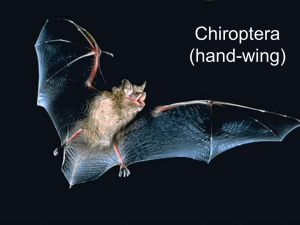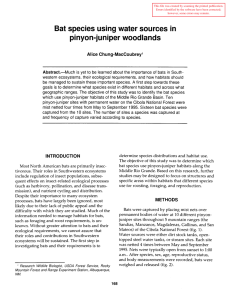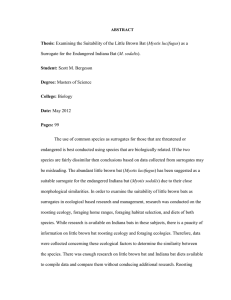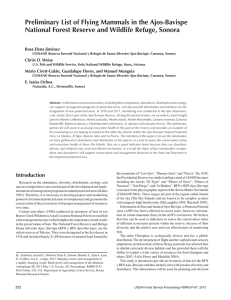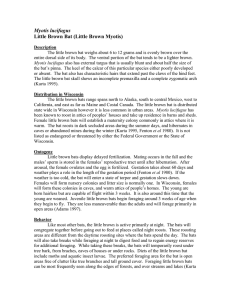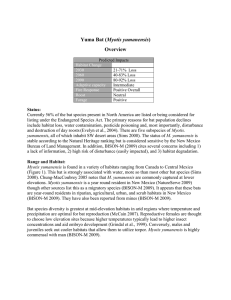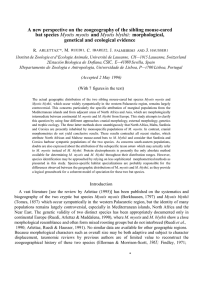1997 winter reproduction m myotis j zool.doc
advertisement
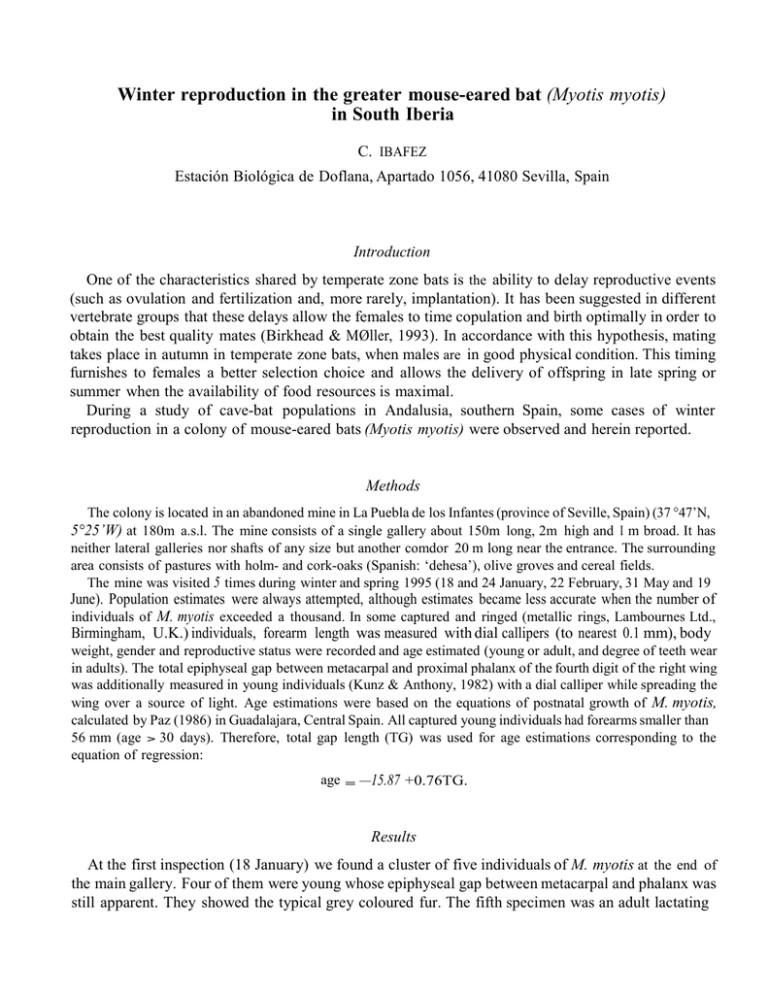
Winter reproduction in the greater mouse-eared bat (Myotis myotis) in South Iberia C. IBAFEZ Estación Biológica de Doflana, Apartado 1056, 41080 Sevilla, Spain Introduction One of the characteristics shared by temperate zone bats is the ability to delay reproductive events (such as ovulation and fertilization and, more rarely, implantation). It has been suggested in different vertebrate groups that these delays allow the females to time copulation and birth optimally in order to obtain the best quality mates (Birkhead & MØller, 1993). In accordance with this hypothesis, mating takes place in autumn in temperate zone bats, when males are in good physical condition. This timing furnishes to females a better selection choice and allows the delivery of offspring in late spring or summer when the availability of food resources is maximal. During a study of cave-bat populations in Andalusia, southern Spain, some cases of winter reproduction in a colony of mouse-eared bats (Myotis myotis) were observed and herein reported. Methods The colony is located in an abandoned mine in La Puebla de los Infantes (province of Seville, Spain) (37 °47’N, 5°25’W) at 180m a.s.l. The mine consists of a single gallery about 150m long, 2m high and I m broad. It has neither lateral galleries nor shafts of any size but another comdor 20 m long near the entrance. The surrounding area consists of pastures with holm- and cork-oaks (Spanish: ‘dehesa’), olive groves and cereal fields. The mine was visited 5 times during winter and spring 1995 (18 and 24 January, 22 February, 31 May and 19 June). Population estimates were always attempted, although estimates became less accurate when the number of individuals of M. myotis exceeded a thousand. In some captured and ringed (metallic rings, Lambournes Ltd., Birmingham, U.K.) individuals, forearm length was measured with dial callipers (to nearest 0.1 mm), body weight, gender and reproductive status were recorded and age estimated (young or adult, and degree of teeth wear in adults). The total epiphyseal gap between metacarpal and proximal phalanx of the fourth digit of the right wing was additionally measured in young individuals (Kunz & Anthony, 1982) with a dial calliper while spreading the wing over a source of light. Age estimations were based on the equations of postnatal growth of M. myotis, calculated by Paz (1986) in Guadalajara, Central Spain. All captured young individuals had forearms smaller than 56 mm (age > 30 days). Therefore, total gap length (TG) was used for age estimations corresponding to the equation of regression: age = —15.87 +0.76TG. Results At the first inspection (18 January) we found a cluster of five individuals of M. myotis at the end of the main gallery. Four of them were young whose epiphyseal gap between metacarpal and phalanx was still apparent. They showed the typical grey coloured fur. The fifth specimen was an adult lactating 0 female with very worn teeth. The temperature in this zone of the mine was 20°C and the bats were in shallow torpor. Another cluster in the smaller gallery was formed by seven M. myotis and four Miniopterus schreibersii. All M. myotis, two males and five females, were adults with worn to very worn teeth. Three of the females had their nipples developed as if they were lactating, but had no milk at that moment and the subjacent mammary glands were not swollen. The nipples of the other two females were moderately developed. The bats of this cluster were in deep torpor. The temperature inside the gallery is influenced by the outside temperature and, though it could not be measured, it was notably lower than that in the first gallery. In fact, it was freezing in previous nights, with a minimum record of —6°C four days earlier (14 January). On this occasion, no measuring, weighing or ringing could be carried out. In the same spot in which we had observed the five young M. myotis, some 50 individuals of this species were found six days later (24 January). They were awake but did not show much activity. The temperature in this part of the mine was 22°C. Five adults and three young individuals occupying the centre of the cluster were captured. The measurements of the young and their age estimates are shown in Table I. The age of the three young would be between 44 and 57 days (95% confidence interval). According to this estimate, their birth would have taken place at the beginning of December 1994. There appeared to be no more young in the cluster. Three of the adults were females, one in an advanced stage of gestation (body mass: 36 g). The other two females were not apparently pregnant, although they weighed 28.5 g and 30 g, respectively. Two of the females had very worn teeth, while the third female and the males showed worn teeth. On 22 February, a colony of more than a thousand M. myotis were roosting in the main gallery. Twenty-one individuals were captured, 18 adults (2 males and 16 females) and 3 young (2 males and 1 femak). The measurements and age estimates of the young are shown in Table I. Two of the young had TABLE I Characteristics of young bats captured at dfferent occasions during the study. Forearm length (FA) and total epiphyseal gap length (TG) in mm, weight in g and age in days. The fledging in Central Spain occurs at the age of 43 days with a mass of 23.1 g anda forearm length 0161.2 mm (Paz, 1986) Date and Individual Sex FA Weight TG Age M F F 58.3 57.8 56.8 18.5 19.5 21.0 4.0 4.6 4.2 53.5 48.9 52.0 M F M 59.0 58.9 59.3 23.5 23.5 21.5 1.0 0.8 4.8 76.9 78.5 47.3 M M M M M F F F 60.3 60.6 62.2 61.5 62.3 59.6 64.5 62.9 25.0 24.5 23.5 21.0 24.5 21.5 26.5 23.5 3.4 5.7 4.7 3.6 5.6 6.4 5.5 7.0 58.2 40.3 48.1 56.7 41.1 34.8 41.9 30.2 24 January 2 3 22 February 1 2 4 31 May 5 6 7 8 9 10 11 12 been captured before (specimens No. 1 and No. 2 in Table I). The age differences between the two estimates (made 29 days apart) on the recaptured individuals were 22 and 29 days, respectively. The other young, estimated 47 days old, was born at the beginning of January and should have been around 20 days old at the previous visit. This young was probably born elsewhere, since its presence would have been certainly detected if it had been in the mine at the previous visit. None of the adult females captured was lactating. The temperature of the zone in which the colony was located, varied between 20 and 22 °C in the two visits. On 31 May, the colony consisted of several thousand individuals of M. myotis, many of them young. Eight young were captured and measured. The age estimates varied between 30 and 59 days (mean 44 days, see Table I), which indicates that they were born throughout April. On 19 June, the colony again consisted of several thousands of bats, some of them M. blythii. The majority of the young showed a total gap length of less than1 mm, even though all were still nonvolant suckling. The young individual No. 2 (ringed in January and checked again in February), was again recaptured. The temperature between February and June was constant in the range of 20—22 °C. Discussion Myotis myotis is one of the early-breeding bat species which has its young during a broad range of time (Brosset, 1955; Brosset & CaubIre, 1959; Kowalski et al., 1986). As an extreme case, a female carrying two foetuses was captured in October in Tunisia (Baker et a!,, 1974). Mouse-eared bats of North Africa are considered here as M. myotis, according to Arlettaz et al. (1997). This earliness could be due to their feeding preferences on rather big-sized terrestrial arthropods (Bauerová, 1978; Audet, 1990; Arlettaz, Ruedi & Hausser, 1993), whose abundance is less temperature-dependent than for flying insects (Lewis, 1993). Birth took place during April for the greater part of the colony. If the intra-uterine life span is about 50 days (Herlant, 1956), ovulation and fertilization must have occurred during February, when the colony arrived at the refuge. The reported birth dates are the earliest known for Europe (Brosset & Caubère, 1959; Paz, 1986), including Central Spain (end of May and June), and are similar to those described by Kowalski et al. (1986) for Algeria. Ovulation for young born in December must have occurred at the beginning of October. It means that these bats did not hibernate that year, possibly owing to the warm and dry conditions of that autumn (Table II) and the associated greater prey availability. The three females with developed nipples that were found on 18 January in the smaller gallery probably are the mothers of three of the young of the main gallery. The use of alternate low temperature day roosts during cold periods related with no foraging activity is known at lactation in M. myotis and Myotis emarginatus (Audet, 1990; Krull et al., 1991). This behaviour contributes to reduce thermoregulatory costs as bats could use deep torpor in energetic deficit periods (Audet, 1990). The time of breeding is an important fitness factor in animals. Generally, individuals born first within the breeding period have important advantages regarding survival and social dominance. These advantages are maintained for an important part of their lives (i.e. Svensson, 1995 for birds and Green & Rothstein, 1993 for mammals). It has been shown in temperate zone bats that young born early have more opportunities to accumulate reserves in order to survive their first winter (Racey, 1982). The advantages of an earlier birth can be maintained throughout life. Individuals of Rhinolophus ferrumequinum which were born during the second half of the breeding period had a lower probability of living for more than 10 years than those which were born earlier (Ransome, 1989). It is therefore not surprising that females try to have their young as early as possible, although it may be that only females in good physical condition are able to reproduce early. In R. ferrumequinum, older females TABLE II Meteorological variables in the study area. Monthly mean values oft maximun temperature (maxT), minimum temperature (minT), number of days with minimum temperature below zero (minT<O°C), number of days with maximun temperature over 25°C (maxT> 25 °C) and precipitation (precip). Mean temperature values of last 10 years, and mean precipitation values of last 20 years. Same values of 1994 within parentheses Month 8 9 10 11 12 maxT (°C) minT (°C) minT<0 °C (days) maxT>25 °C (days) precip (mm) 36.4/(37.5) 32.0/(31.3) 24.0/(26.5) 18.8/(20.7) 15.21(15.7) 17.1/(17.8) 14.9/(13.4) 11.5/(11.5) 6,91(6.9) 4.41(2.3) 01(0) 01(0) 01(0) 21(0) 51(10) 31/(31) 29/(28) 151(24) 11(0) 01(0) 4.41(0) 17.4/(3.5) 79.71(45.5) 121.6/(89.5) 113.91(7.1) were in better physical condition with higher body mass both at the beginning and end of hibernation (Ransome, 1968). Milligan & Brigham (1993) found that early reproduction and age were coincident in females of Myotis yumanensis. In the present study, the females that gave birth in winter were old too (worn to very worn teeth), and the survival rate of the young seems not to have been affected, in spite of the low temperatures; which reached below zero during 10 nights in December and 16 more nights in January (on none of our visits in January and February was any carcass of young found). Although as a result of their early birth date, body masses and forearm lengths of the winter-born young were lower than those born in spring in this colony and in the one of Central Spain (Table I) (Paz, 1986). This fact, atso shown in late-born R. ferrumequinum, appears to be a long-term handicap to successful breeding (Ransome, 1989). I am grateful to A. Lafuente, L. Lara, E. Migens, J. L. Pérez-Jordá and J. Quetglas for assistance in field work. J. Juste, R. Arlettaz and P. Racey provided helpful comments on the manuscript. This study was supported by the Agencia de Medio Ambiente (Junta de AndalucIa). REFERENCES Arlettaz, R., Ruedi, M. & Hausser, 3. (1993). Ecologie trophique de deux espèces jumelles et sympatriques de chauves-souris: Myotis myotis et Myotis blythii (Chiroptera, Vespertilionidae). Premiers résultats. Mammalia 57: 519—531. Arlettaz, R., Ruedi, M., Ibáflez, C., Palmeirim, J. & Hausser, J. (1997). A new perspective on the zoogeography of the sibling mouse-eared bat species Myotis myotis and Myotis blythii: morphological, genetical and ecological evidence. .1. 2ool. (Lond.) 242: 45—62 Audet, D. (1990). Foraging behavior and habitat use by a gleaning bat Myotis myotis (Chiroptera: Vespertilionidae). J. Mammal. 71: 420—427. Baker, K. J., Davis, B. L., Jordan, R. G. & Binous, A. (1974). Karyotypic and morphometric studies on Tunisian mammals: bats. Mammalia 38: 695—710. Bauerová, Z. (1978). Contiibution to the trophic ecology of Myotis myotis. Folia Zool. 27: 305—316. Birkhead, T. R. & MØIler, A. P. (1993). Sexual selection and temporal separation of reproductive events: sperm storage data from reptiles, birds and mammals. BioL I. Linn. Soc. 50: 295—311. Brosset, A. (1955). Observations sur Ia biologie des chiroptires du Maroc onentale. Bull. Soc. Sci. Nat. Phys. Maroc 35: 296— 306. Drosset, A. & Caubère, 13. (1959). Contribution a l’étude écologique des chiroptires de I’ouest de Ia France et du bassin Paiisien. Mammalia 23: 180—238. Green, W. C. H. & Rothstein, A. (1993). Persistent influences of birth date on dominance, growth and reproductive success in bison. J. Zool. (Lond.) 230: 177—186. Herlant, M. (1956). Correlations hypophyso-génitales chez Ia femelle de Ia chauve-souris, Myotis myotis (Borkhausen). Arch. BioL 67: 89—180. Kowaiski, K., Gaisler, J., Bessam, H., Issaad, C. & Ksantini, H. (1986). Annual life cycle of cave bats in northern Algeria. Acta Theriol. 13: 185—206. Krull, D., Schumm, A., Metzner, W. & Neuweiler, G. (1991). Foraging areas and foraging behavior in the notch-eared bat, Myotis emarginatus (Vespertilionidae). Behav. Ecol. Sociobiol. 28: 247—253. Kunz, T. H. & Anthony, E. L. p. (1982). Age estimation and post-natal growth in the bat Myoris lucifugus. J. Mammal. 63: 23—32. Lewis, S. E. (1993). Effect of climatic variation on reproduction by pallid bats (Antrozous pallidus). Can. J. Zool. 71: 1429— 1433. Milligan, B. N. & Brigham, R. M. (1993). Sex ratio variation in the yuma bat (Myotis yumanensis). Can. J. Zeal. 71: 937—940. Paz, 0. de (1986). Age estimation and postnatal growth of the greater mouse bat Myotis myotis (Borkhausen, 1797) in Guadalajara, Spain. Mammalia 50: 243—251. Racey, P. A. (1982). Ecology of bat reproduction. In Ecology of bats: 57— 104. Kunz, T. H. (Ed.). New York: Plenum Press. Ransome, R. D. (1968). The distribution of the greater horse-shoe bat, Rhinolophus ferrumequittum, during hibernation, in relation to environmental factors. J. Zool. (Lend.) 154: 77—112. Ransome, R. D. (1989). Population changes of greater horseshoe bats studied near Bristol over the past twenty-six years. Biol. J. Linn. Soc. 38: 71—82. Svensson, E. (1995). Avian reproductive timing: when should parents be prudent? Anim. Behav. 49: 1569—1575. J. Zool., Lond. (1997) 243, 840—846 Are major roads a barrier to small mammals? J. H. RICHARDSON, R. F. SHORE’, J. R. TREWEEK N.E.R.C., Institute of Terrestrial Ecology, Monks Wood, Abbots Ripton, Huntingdon, Cambridgeshire, PEI7 2LS, U.K. AND S. B. C. LARKIN S.A.F.E., Cranfield University, Silsoe Campus, Silsoe, Bedford MK45 4DT Introduction Road networks are developing and expanding in many countries. Great Britain alone has approximately 365,000 km of roads and this figure is increasing each year (Department of Transport, 1995). Although verges associated with roads may provide suitable habitat for small mammals (Way, 1977; Adams & Geiss, 1983; Perrow, 1994; Ardeshir et at., subm.), roads themselves are linear features which may act as a barrier to movement. Thus, roads may fragment habitats. Several studies have specifically investigated the impact of roads on the movement of small mammals. Oxley, Fenton & Carmody (1974) trapped small mammals adjacent to roads of varying width and traffic density in the U.S.A. and concluded that roads inhibit movement, the most important factor probably being road clearance (distance between vegetation cover on either side of the road). In Canada, white-footed mice Peromyscus leucopus were recorded crossing a 3.3—6.4 m wide gravel road infrequently, even though traffic density was only 1—2 vehicles per hour (vph), and it was concluded that small forest roads were inhibitors of movement but not absolute barriers (Merriam et at., 1989). ‘Author to whom correspondence should be addressed

